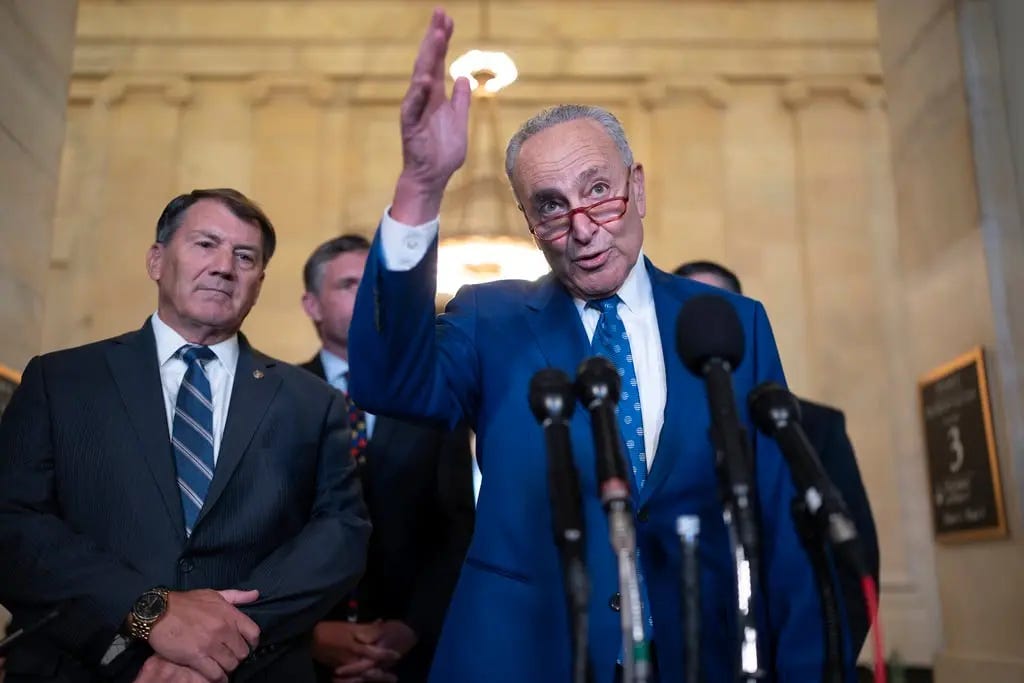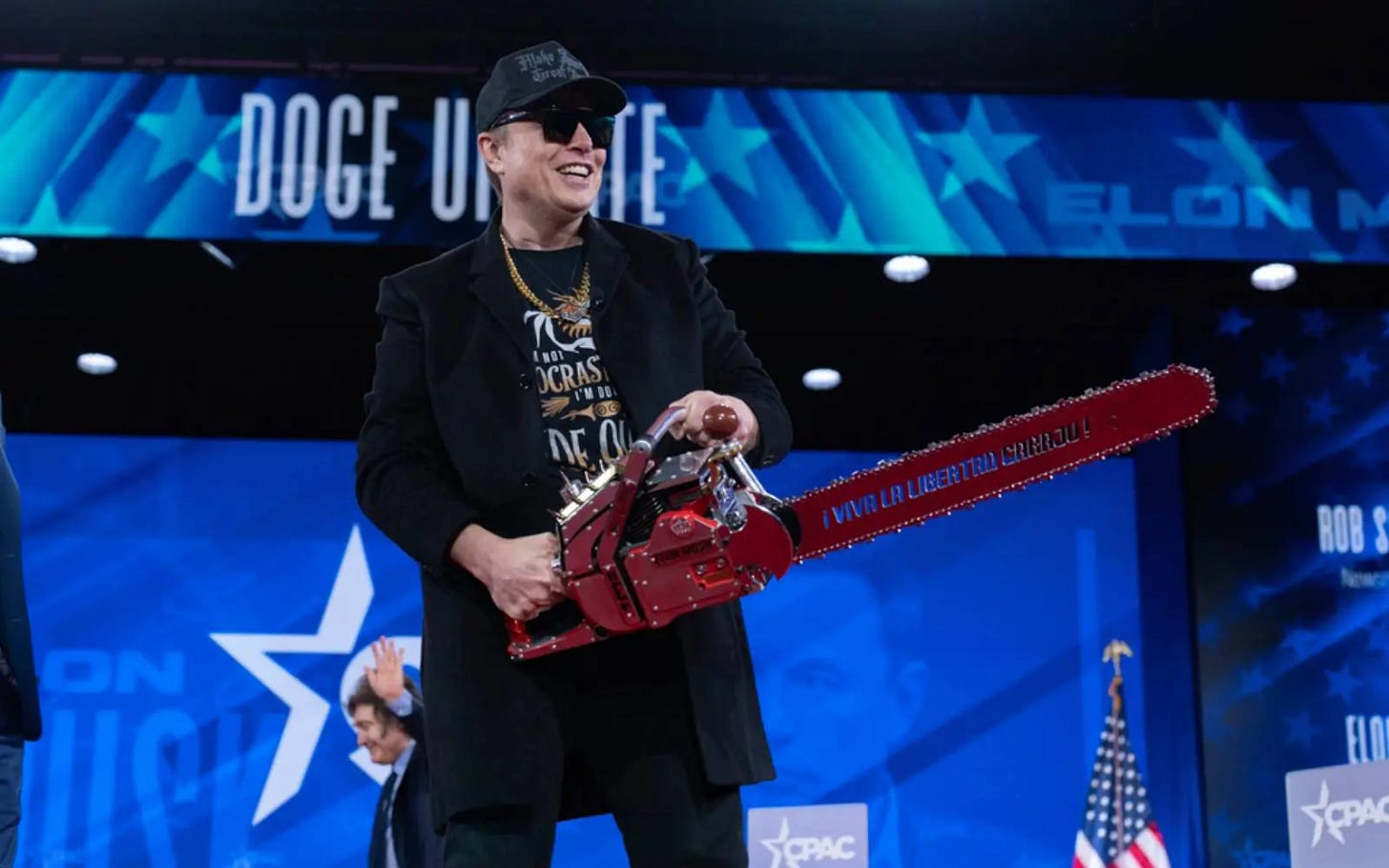Breaking Down Schumer's Support for a Stopgap: Avoiding a Shutdown to Protect Federal Institutions, Oversight, and Enforcement
Analyzing Senator Chuck Schumer's controversial choice to back the GOP's stopgap reveals the critical risks he sought to avoid: handing Trump a direct pathway to dismantle oversight and institution
Earlier today, Congressional Democrats faced a critical decision: either pass an unfavorable GOP-written short-term funding bill (a “stopgap”) or allow the federal government to shut down. While House Democrats voted against the bill, Senate Minority Leader Chuck Schumer (D-NY) surprised and angered many on the left at the 11th hour by leading ten Senate Democrats into supporting the stopgap bill despite significant objections within the party. Critics quickly labeled Schumer’s choice as “surrendering” and argued that Senate Democrats should have held their ground. However, Schumer defended his decision as necessary to avoid handing President Trump—back in office and backed by influential billionaire Elon Musk—a golden opportunity to dramatically weaken or dismantle critical federal institutions under the cover of a shutdown.
This article analyzes Schumer’s rationale, exploring the immediate risks he sought to avoid, the real-world impacts of government shutdowns, and the strategic considerations behind his controversial decision. The question is not simply whether the stopgap bill was flawed—it was—but whether the potential damage from a government shutdown during Trump’s administration posed a far greater threat.
Immediate Risks: Why Schumer Feared a Shutdown Under Trump

Despite its flaws, Senate Minority Leader Chuck Schumer's decision to back the GOP's stopgap funding bill was driven by the severe consequences a government shutdown would have on federal institutions. Schumer and his Senate allies voiced concern that shutting the government down now would not just be a pause in governance but also give the Trump Administration an ideal opportunity to weaken federal agencies permanently. With President Trump back in office and openly hostile to the 'administrative state,' Democrats feared the administration would exploit a shutdown to aggressively slash government infrastructure, encouraged by allies like Elon Musk. Schumer believes a shutdown would "play into Trump and Musk's hands," allowing them to put this "slash-and-burn campaign into overdrive." During a funding lapse, the White House would have wide latitude to deem entire agencies or programs "non-essential," furloughing staff without guaranteeing they'd ever be rehired. In other words, agencies would be shuttered and their expertise permanently wiped out under a temporary furlough, likely leading to significant abuse of executive power and loss of critical oversight.
Evidence for these fears emerged in the form of concrete plans from the Trump team. Last month, President Trump issued Executive Order 14210, directing agencies to prepare for mass layoffs ("Reductions in Force") aimed at shrinking the federal workforce. Notably, the order suggested using the shutdown to identify "non-essential" staff and then eliminate those positions permanently. One category targeted by the administration was anyone who does not work through a shutdown – an estimated 700,000 federal workers could be slated for termination on that basis. This unprecedented approach signaled an intention to use a shutdown as cover to dismantle parts of the government. Musk, a close outside adviser and supporter of Trump, has openly called for drastic cuts – even to "delete entire agencies" from the federal government. He champions an ethos of trimming bureaucracy (a philosophy he has applied in his businesses), and reports indicated Musk favored a shutdown specifically because it would make it easier to eliminate federal jobs and programs swiftly. Democratic lawmakers echoed these concerns: one warned that passing on the fight would give "Trump and Musk unchecked power to line their pockets" by removing regulatory obstacles. Schumer and others believed a shutdown during Trump's term wouldn't be a routine political standoff – it could hand anti-government actors an opening to erode institutional checks with minimal resistance. This high-stakes context weighed heavily in Schumer's decision, particularly the potential loss of critical expertise and the urgency of maintaining institutional continuity.
The Real-World Consequences of Shutdowns on Federal Oversight

Shutdowns cripple government oversight and regulatory enforcement, as large portions of federal staff are furloughed and agency work grinds to a halt. For example, inspectors general have warned that they "cannot conduct effective oversight during a shutdown" when much of their staff is furloughed. However, the long-term effects are equally concerning as key regulators are also hobbled. During the 2018–2019 funding lapse – the longest in U.S. history – the Securities and Exchange Commission was forced to suspend nearly all enforcement actions, leaving only a skeleton crew for emergencies. The SEC's enforcement division "virtually went dark," initiating only one action in January 2019, when it would typically commence dozens, illustrating how "bad actors" can exploit a shutdown, operating with far less fear of federal scrutiny.
Other agencies face similar rollbacks in a shutdown. The Federal Election Commission noted that campaign finance enforcement "ground to a halt" after 90% of its staff were furloughed in the 2019 shutdown. Workplace safety inspections by OSHA are curtailed, leaving workers at risk as regular oversight stops. Environmental protections are delayed or abandoned – for instance, the Environmental Protection Agency must stop most inspections of drinking water facilities and halt reviews of pollution permits during a shutdown. Even public transparency is undermined: agencies slow or outright suspend processing of Freedom of Information Act requests, creating information blackouts. In short, a funding lapse doesn't just pause government services – it erodes the safeguards and accountability measures that keep government and powerful interests in check. Schumer and many Democrats knew a shutdown would weaken these institutional checks on power at every level.
Historical Precedents of Weakened Governance During Shutdowns

History shows that government shutdowns can undermine oversight and effective governance, sometimes with lasting effects. During the 2013 shutdown, environmental and safety regulators like the EPA had to stop routine inspections and enforcement, contributing to backlogs in oversight duties. The abrupt halt in operations delayed justice and corrective action and encouraged opportunistic behavior in the interim. Similarly, the 35-day shutdown of 2018–2019 under the Trump administration vividly demonstrated how governance can be hamstrung. Besides stalled SEC and FEC enforcement, the Department of Justice reported that many civil investigations and litigation efforts were put on hold since only activities protecting human life or property continued. The Justice Department's Inspector General later confirmed that effective oversight was impossible with oversight staff furloughed while agencies continued limited operations. This lapse strained the system: ethics inquiries were delayed, and agency watchdogs could not fully pursue ongoing probes.
These episodes also highlight how checks on executive power can lapse. For example, during the 2018–2019 impasse, the Office of Special Counsel, which enforces ethics laws like the Hatch Act, was reduced to a bare-bones team unable to investigate political abuses in real time. The Merit Systems Protection Board, which handles whistleblower and personnel appeals, furloughed its entire staff. Such gaps meant executive branch officials faced little immediate accountability for potential misconduct. Each shutdown has shown that critical oversight and governance functions are collateral damage, taking weeks or months to recover. Past shutdowns have also proven politically counterproductive for those seen as causing them. In 1995–96, a budget impasse shut the government twice and weakened public confidence in Congress, a blow to Newt Gingrich's House Republicans. In 2013, the attempt to force policy changes by shuttering the government backfired on the instigators, who were blamed for dysfunction. These historical lessons reinforced Schumer's wariness about entering a shutdown gamble. Sacrificing governance – even temporarily – can inflict real damage on federal institutions. Schumer argued that repeating this history would be especially perilous under the current circumstances, potentially leading to long-term erosion of institutional checks on power.
Strategic Rationale: Stability Now, Opposition Through Other Channels
By supporting the stopgap funding bill, Schumer chose short-term governance stability over a high-risk confrontation. He acknowledged the bill was far from ideal – a Republican-written patch that cut roughly $12 billion from domestic programs, boosted funding for policies Democrats opposed (like expanded migrant deportations), and failed to restrain Trump's ability to reprogram congressionally approved funds. These flaws prompted outrage on the left, who saw acceptance of the bill as a "tremendous mistake" and a needless concession. Progressive activists derided the move as the "Schumer surrender" and argued that a brief shutdown might have been a worthwhile risk to force Republicans' hand. However, Schumer defended his choice as a necessary trade-off to protect the country from more significant harm. He presented a two-fold argument in a Senate floor speech and an op-ed. First, a shutdown would be a "gift" to Donald Trump – a distraction from Trump's agenda and a crisis that Trump could exploit rather than shoulder blame for. Schumer argued that Democrats would be sucked into fights over reopening agencies instead of spotlighting the "damage Donald Trump's agenda is causing." Second, he asserted that governing responsibly was crucial to show Americans – mainly middle-class voters – that Democrats put stability and public interest first. In his view, entering a shutdown with no clear endgame would hurt ordinary people (through lost services and paychecks) and undermine the party's commitment to pragmatic governance.
Schumer's strategic calculus was that keeping the government open maintained stability and preserved the tools of opposition for use in other arenas. By averting a shutdown, Democrats ensured that congressional committees, inspectors general, and courts could continue to operate, providing avenues to check the Trump administration. Even in the minority, Democrats can use hearings, investigations, and public advocacy to oppose objectionable policies – tactics far more effective when the government functions normally. Indeed, congressional operations are mainly exempt from shutdown furloughs, so maintaining funding keeps legislative oversight on track. Passing the stopgap also buys time for opponents of Trump's agenda to regroup and fight future battles under better conditions rather than amid the chaos of a shutdown. Schumer's supporters note that this move prevents an immediate institutional crisis, allowing Democrats to continue pushing back through regular order: for example, they can still introduce bills to reverse unpopular measures, scrutinize agency actions in real-time, and engage the public with a unified message – all without the distraction of a self-inflicted shutdown. In essence, Schumer chose to defuse the immediate threat (the shutdown) so that political opposition could carry on through normal democratic channels rather than from within a government in disarray.
Balancing Governance and Leverage

Schumer's decision highlights the classic dilemma of when to compromise and when to confront. By supporting the stopgap bill, he prioritized keeping federal agencies running and accountable – preserving the "guardrails" of democracy – over using a shutdown as leverage. While angering some activists and lawmakers, this approach was a bet that maintaining governmental stability would ultimately strengthen the long-term fight against the Trump administration's agenda. History suggests that shutdowns often weaken the oversight and accountability the minority relies on to constrain an overreaching executive. Schumer leaned on this historical insight and expert warnings when making his choice. As one public interest advocate noted, it was a "challenging" call: a temporary shutdown can be a form of protest, but passing a bad bill at least keeps the lights on and the institutions intact for continued resistance. Schumer himself framed it as a patriotic duty to put country over party in the immediate term. He argued that ceding this round would deny Trump the chaos he "owns" and prevent handing him unchecked power in the shadows of a shutdown. In the coming months, Democrats plan to fight on policy fronts outside the budget process – from court challenges to public campaigns – without also having to rebuild a shuttered government.
Schumer's support for the flawed stopgap can be seen as choosing the "lesser of two evils," a strategic sacrifice to safeguard federal governance and oversight. The sacrifice avoids a scenario where critical checks on executive power would be weakened or removed under the cover of a funding lapse. While the decision sparked backlash and debate within the Democratic Party, it reflects a calculation that preserving the continuity of government was paramount when faced with an administration eager to diminish it. By keeping agencies open and accountable, Schumer aims to ensure that opposition to President Trump's policies can continue vigorously – just in a way that doesn't imperil the basic functioning of government. The sacrifice neutralizes one immediate threat (a destabilizing shutdown) while deferring fights to more favorable battlegrounds, echoing historical lessons that safeguarding institutions is often the wiser course when governance is at stake.


